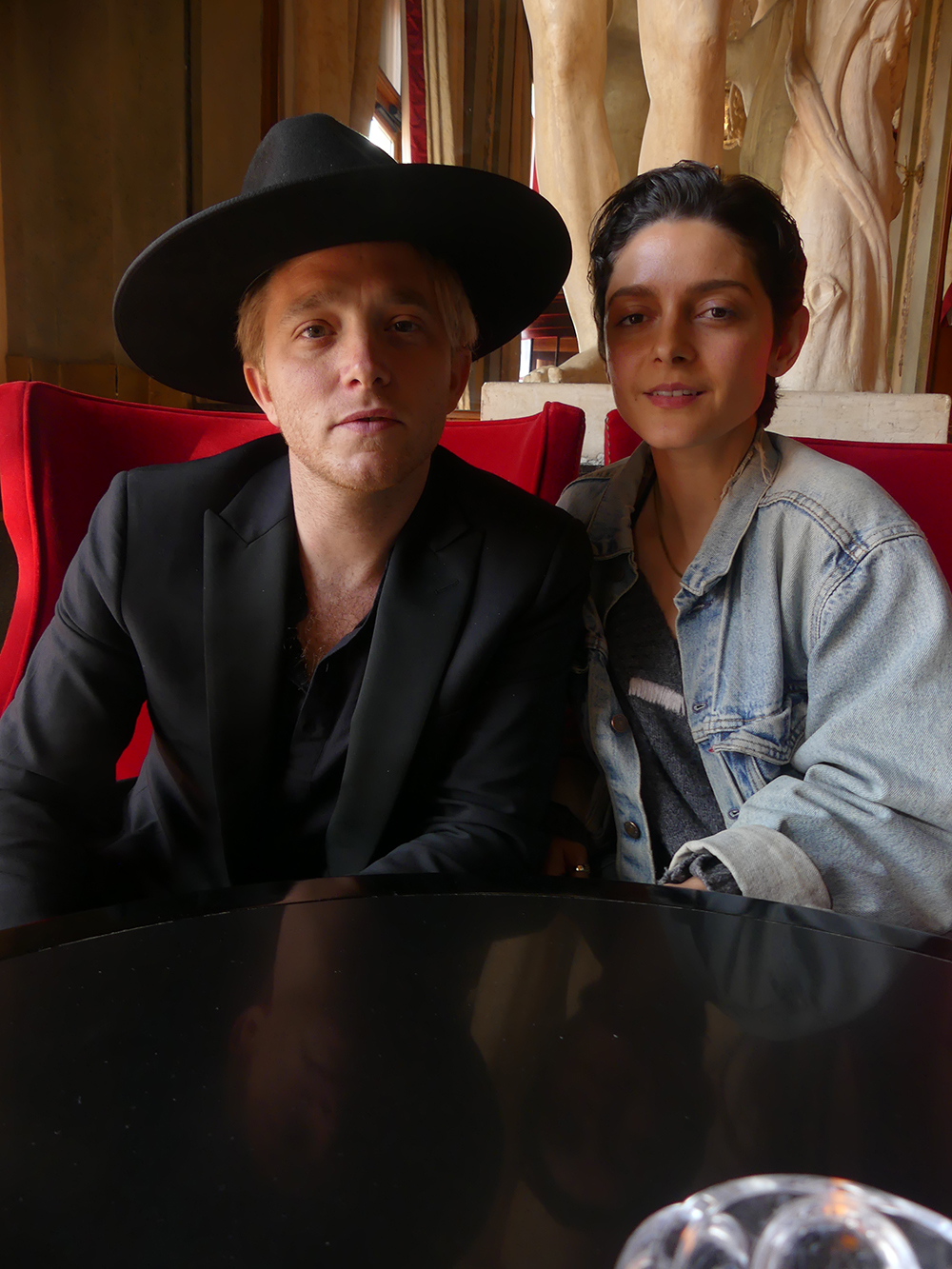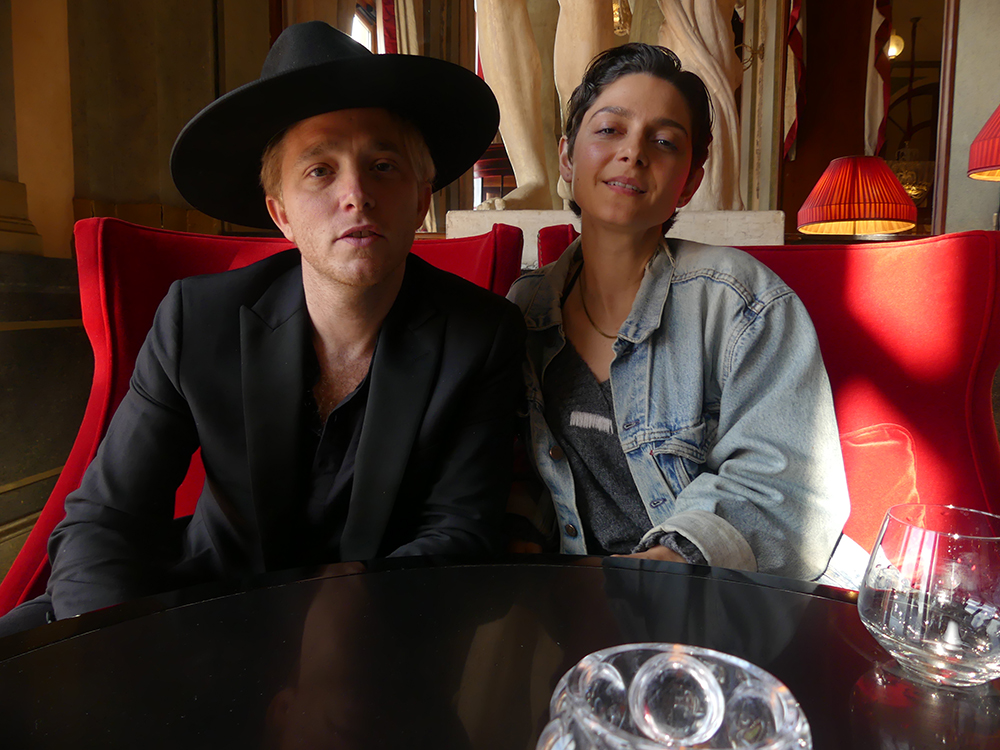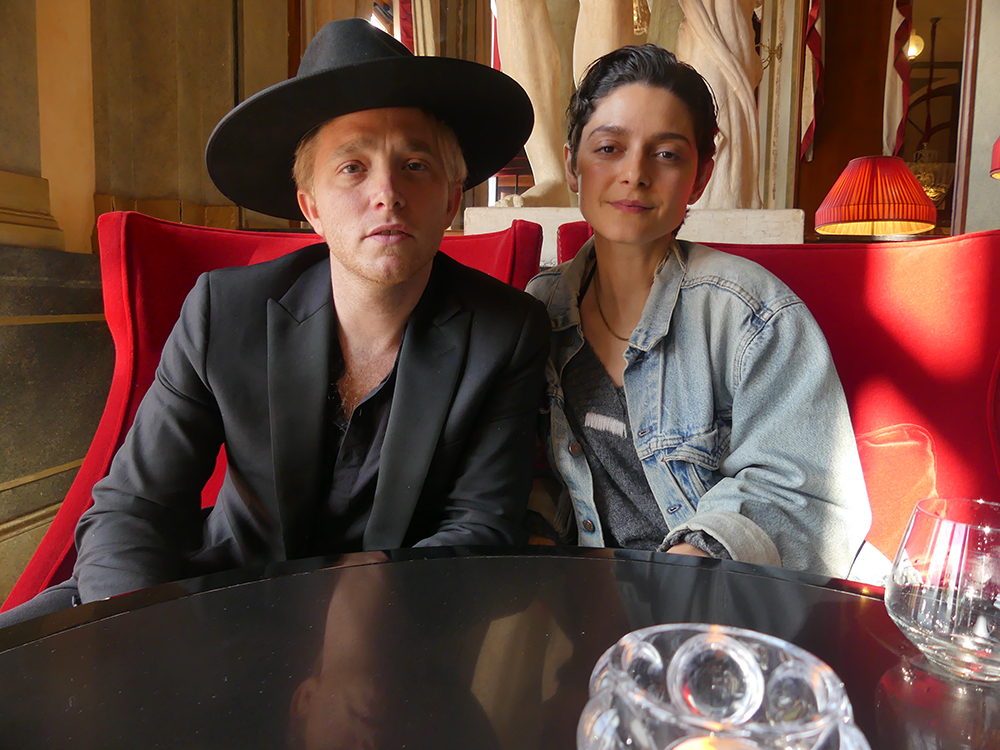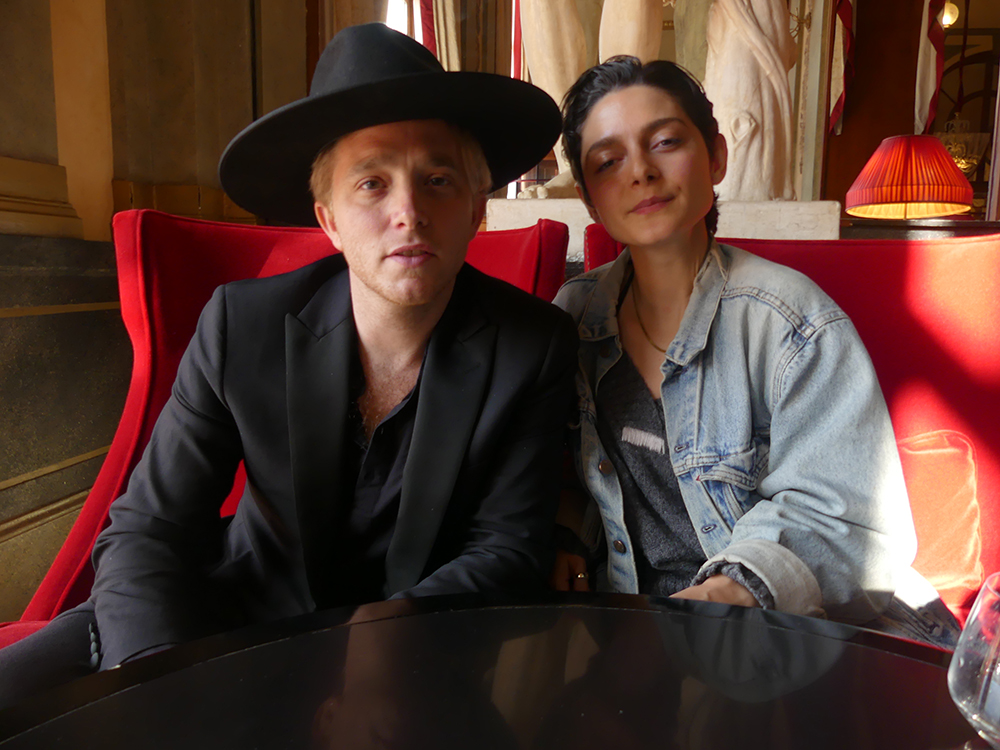Festivals - FCAD 2024 : In Conversation about Gazer with Ryan J. Sloan and Ariella Mastroianni
By Mulder, Deauville, Hotel Barriere The Royal, 11 september 2024

The 50th Deauville American Film Festival showcased an impressive lineup of emerging talents, with Gazer, directed by Ryan J. Sloan, standing out as one of the most talked-about films in competition. This emotionally charged psychological thriller tells the story of Frankie, a young mother grappling with dyschronometria, a condition that distorts her perception of time. Faced with financial pressures, she takes on a risky job, unaware of the dark consequences that lie ahead. Ariella Mastroianni delivers a raw and gripping performance as Frankie, heightening the film's tension and emotional depth.
The film's haunting atmosphere is enhanced by Matheus Bastos' striking cinematography and an eerie score from Steve Matthew Carter, perfectly capturing the protagonist's chaotic mental state. Audiences at Deauville responded positively to Gazer, praising its blend of suspense and emotional intensity. Post-screening Q&As with Sloan and Mastroianni offered deeper insights into the creative process, revealing the film as a passion project for both. Gazer is a standout example of innovative indie storytelling that has left a lasting impression on the festival.
Q: What was the inspiration behind the story of The Gazer ?
Ryan J. Sloan: Well, we started writing in 2020 during COVID. Up to that point, we were living lives that we didn’t necessarily love. I was working as an electrician, and Ariel was working at a movie theater.
Ariella Mastroianni: But I was furloughed, so I was let go during that time.
Ryan J. Sloan: I was actually considered an essential worker, so I had to keep working. But we were at this crossroads where we were reflecting on our lives—where we’d been and where we wanted to go. We decided that we just needed to make that movie, to make that jump, whatever it takes. We had a little bit of money saved up, no connections, no financial support, but we started writing this film. We were looking at films from Alan J. Pakula, Francis Ford Coppola’s The Conversation, Antonioni’s Blow-Up, and Brian De Palma’s Blow Out. We got very inspired by those three films, particularly because they were all inspired by Antonioni’s Blow-Up—this idea of a character witnessing something, misunderstanding it, or misconstruing it, and how that affects them mentally. So we asked, “What would be that fourth film in today’s day and age?” We chose this character who is forced to live an analog life in a digital world, and that was very exciting to us. Ariel had read Oliver Sacks’s The Man Who Mistook His Wife for a Hat, and she was reading about all these conditions, and she—I'm speaking for you.
Ariella Mastroianni: No, that’s it. I mean, that was the jumping-off point. We were looking at these films and just thought, “God, these are so good, and we haven’t seen a film like this in a while.” So we knew we wanted to have a paranoia film, a really complicated and fun mystery.
Q: How did you connect with your character, and what personal experiences or thoughts did you bring to the role ?
Ariella Mastroianni: Well, one thing that really moved me when I was researching was looking for people who had this condition firsthand. I came across this NPR piece, paraphrasing, but it can be very frustrating. So what she does is she embraces it; she takes moments to give herself time to be internal and inward. There was something really beautiful but lonely about that. I think, at its core, Frankie is living in this world at the top of the film like a ghost—looking out into other people’s lives, trying very hard not to be seen, to disappear into the world. But she’s also a woman searching for connection, specifically with her daughter. That really fueled the internal life for me.
Q: How did you approach creating the unique tone and atmosphere of the film, and why black & white ?
Ryan J. Sloan: I grew up in the 90s, watching films before the digital age, and they were shot on film. To me, cinema is connected with celluloid. I’ve been playing with film cameras ever since I was a kid. It wasn’t an option to shoot digitally—I knew from the start that we were going to be shooting on film. I want to share that beauty and mystery with people. It’s not about being a rival against digital; there are plenty of digitally shot films that look wonderful. But I connect more with films shot on film. The place I grew up, where we shot, is changing—it’s being gentrified, like many places around the world. I wanted to capture what was left of it before it was gone. It’s a gritty place, in the shadow of New York City, and it lent itself to that 16 mm grain. Ariel, myself, and our great cinematographer Matheus Bastos leaned into that. For the nightmare sequences, we pushed the film stock to get an even grainier texture. Matt had the idea of adding purple into the color grade, which gave it an almost Grindhouse feel. We were always on board to push it and keep getting more grit out of the film.
Ariella Mastroianni: We kept exploring and having fun.
Q: What was the most challenging scene for you to play, and how did you prepare for it emotionally ?
Ariella Mastroianni: You know, we shot this film on weekends over two years, in the spring and fall—not every weekend, thank God! But every weekend had its own set of challenges. I think the most challenging scene was toward the end of the film, where we discover why Frankie is in the position she’s in. It’s the conversation with the antagonist in a very gritty motel. We didn’t have much control over the location. During the scene, a fight broke out in a neighboring room, and cigarette smoke was coming in from the vent. It was a combination of factors that made it difficult to focus. But Ryan was so good at keeping everyone excited. Anytime I felt frazzled, Ryan would pull me aside and help me reset.
Q: Could you talk about the casting process and what you were looking for in the lead actors, especially Ariella ?
Ryan J. Sloan: Absolutely. Ariel and I wrote the film together, and we wrote it specifically for her. When it came to casting, we stole a lot of actors from Ariel’s acting classes. We knew some of these people and didn’t even need to audition them because we knew what they were capable of. For others, we put out a casting notice.
Ariella Mastroianni: We went through about 2,000 submissions for the role of Paige. She was one of the big roles we did an open call for. But, like Ryan said, many performers were friends or classmates. I love that we were able to include our friends in the project.

Q: What were the biggest challenges you faced during filming, and how did you overcome them ?
Ryan J. Sloan: That’s a good question. I think the biggest challenge—though I loved every second of it, and I would do it all again—was that no matter how prepared I was, I always felt underprepared. Every day felt like an uphill battle. We were shooting many things in increments, cheating locations, sometimes shooting scenes months or even years apart. For me, the nightmare sequences were the most fun but also the most challenging. I storyboarded the entire film, but for that part in particular, I feel like I lost the whole crew. Ariel was always on board and super supportive, but I think the crew was like, “What movie is this?” even though they had read the script and seen the storyboards. Our cinematographer, bless him, said at the end of that weekend, “If you get into the edit and this feels weird, don’t be afraid to cut it from the film.” But I said, “Matt, this is going to be in the film. We’re not cutting it.” It was a demanding weekend—normally we worked 8 to 10-hour days, but we were doing 13 to 14-hour days. We were all staying in the same Airbnb, wearing so many different hats. There was blood everywhere—on the ceilings—and some of the gags didn’t go as planned. For example, the Cronenberg hand-through-the-chest effect wasn’t intentional. We were trying to recreate a scene from The Juniper Tree where she puts her hand through someone’s chest, but with limited resources and time, we got what we got. We made the most of it, but it was stressful because we were constantly running out of time and money, and we had to piece everything together based on what we captured.
Q: Can you share your experience working with Ryan as a director? How did he guide you through some of the more complex or ambiguous scenes ?
Ariella Mastroianni: We create together—we make music, and we made this film together, so we have a shorthand. But of course, this was our first time working together in this capacity, so it was fun because we were learning from each other throughout the process. What’s lovely about working with Ryan is that he’s always willing to play and explore. He has a very specific vision, but he knows how to help you arrive at that place where it feels like it’s coming from you. He never forces you into a box, even though he knows exactly what he wants. Ryan and I worked very hard on Frankie’s physicality, her physical nature, and that was the most fun part to develop.

Q: How did you collaborate with the cinematographer to achieve the distinctive visual style of The Gazer ?
Ryan J. Sloan: Ariel was part of these conversations too, since we were producing together. It was me, Ariella, and Matheus Bastos, the cinematographer. We knew we wanted to shoot on film. We watched a lot of films together to prepare—Repulsion by Polanski, Bresson’s Pickpocket (even though that’s black and white), among others. We were constantly talking about textures and pre-planning for challenges we might face. In the beginning, I owned the camera, but it didn’t have a video tap, so I storyboarded everything like crazy. I would show Matt the storyboards, and then he’d show me the eyepiece, and we’d hope we got the shot. Eventually, we got a video tap, so I could see what was going on more precisely. There’s a very personal relationship between the director and DP—so much trust is involved. If one of us falls, the other falls too.
Q: What message or feeling do you hope audiences take away from your character’s journey in The Gazer ?
Ariella Mastroianni: More than anything, when we were writing this, we wanted the audience to feel that at every moment, Frankie needs to do whatever it takes to get back to her daughter. That’s the whole film. I’ve had so many people tell me, after premiering at Cannes and now here at Deauville, “Oh my God, I was so upset for Frankie the whole time!” Her situation is so frustrating. By the end, when she’s finally with her daughter, I hope people feel that it’s bittersweet—like, you’re happy she’s with her, but the circumstances feel a little weird.
Q: How did you prepare to convey the psychological tension that your character experiences throughout the film ?
Ariella Mastroianni: I spoke to some friends who took the responsible track and became doctors—one is a neurosurgeon, and another works with older patients, mainly those with dementia. They gave me insight into how their patients feel day-to-day. It’s very frustrating because they’re aware that something is wrong, but they can’t control it. That creates this internal frustration, and that became the engine for Frankie’s character.
Q: What were your key influences—both films and directors—when shaping The Gazer, especially in terms of its visual and narrative elements ?
Ryan J. Sloan: As I mentioned earlier, I’m always watching films. I try to watch a movie a day, and during COVID, I rewatched some specific ones—The Third Man by Carol Reed, The Conversation by Coppola, Antonioni’s Blow-Up, L’Avventura, and De Palma’s Blow Out. I love how Antonioni composes his shots and creates slow but intentional spaces for the characters. De Palma is also a big influence—he’s from Jersey, like me. Carlito’s Way and Blow Out were key references. Alan J. Pakula’s paranoia films were another massive influence. His work with Gordon Willis, not being afraid to let people fall into complete darkness, is something I admire. A newer film that really struck Ariel and me was Lee Chang-dong’s Burning. That film rewards you on rewatch, and that was very important to me while shooting The Gazer—placing the camera in a way that, on a second viewing, audiences might notice something they didn’t the first time. David Cronenberg, David Lynch, and Stanley Kubrick were also big inspirations. With Cronenberg, I’m always in awe of his work—films like Videodrome, eXistenZ, and Crash have textures that I admire.
Q: How did your understanding of the character evolve from the first day of shooting to the last ?
Ariella Mastroianni: I think I experienced more of an evolution as an actor in general than in the character specifically. When we started, this was our first attempt at doing anything like this, so there were certain technical elements that I hadn’t experienced before—hitting very specific marks, having only one or two takes, nailing specific eyelines. All the technical requirements of shooting on film were difficult in the beginning, but by the end of the two and a half years, those technical elements became easier, and we were able to really just play.

Q: How do you balance storytelling with ambiguity, especially in scenes that leave much unsaid ?
Ryan J. Sloan: That goes back to Burning in a way. That film lives in ambiguity, which is why it rewards you on rewatch. In The Gazer, the ambiguity was written into the script from the start. We knew the final shot from the beginning—we knew our beginning and our end, and we filled in the rest as we went. There’s a lot that happens off-screen, similar to The Third Man. Graham Greene, the screenwriter, wrote a novella before the screenplay because so much of the story happens off-screen. With The Gazer, we leave a lot open, and while some people might have an issue with that, I love films like that—films where you can map out what happened in your head and, on a rewatch, you piece together things you didn’t catch before.
Ariella Mastroianni: That’s a really good point. It’s not ambiguous for the sake of being open-ended. If you look for the details, the ambiguity is clarified.
Q: What does it mean to you to have The Gazer in the official competition at the Deauville American Film Festival ?
Ariella Mastroianni: It’s the 50th anniversary. There’s so much history here.
Ryan J. Sloan: There are so many great filmmakers here, and we’ve met so many wonderful people. This has been such a beautiful experience. What’s special about Deauville is that we’re all stuck here together in this beautiful place, drinking and talking. You can meet your heroes, and you realize they’re just human like you. Everyone is struggling in the same way.
Ariella Mastroianni: Everyone is here to celebrate film. The audience at Deauville—it’s a big space, but it feels so warm and generous.
Ryan J. Sloan: 1,500 people show up every day.
Ariella Mastroianni: So far, we’ve only been to two festivals, both in France, and the respect for cinema here is unparalleled. I’m so grateful and honored.
Ryan J. Sloan: I’ve never wanted to live anywhere else in my life.
Ryan J. Sloan is an emerging filmmaker known for his bold storytelling and innovative approach to indie cinema. As the director and co-writer of The Gazer, he showcases a keen ability to blend psychological depth with suspense, creating a film that explores complex themes like the fragility of time and memory. Sloan’s attention to detail, from the striking cinematography to the haunting score, reflects his commitment to crafting a cohesive and immersive experience for the audience. His passion for filmmaking is evident not only in The Gazer’s execution but also in his collaborations with the cast, particularly with lead actress Ariella Mastroianni, with whom he co-wrote the film. Ryan J. Sloan’s work at the 50th Deauville American Film Festival solidifies his place as a rising talent in the world of independent film.
You can discover our exclusive photos on our Flickr page
Synopsis:
Frankie suffers from dyschronometry, a degenerative disease that prevents her from perceiving time correctly. Prone to paranoia and frequent blackouts, she records messages on cassette tapes to keep track of herself and ensure her safety. Unable to find steady work in her condition, and in search of money to regain custody of her young daughter, she accepts a mission proposed by a woman with murky intentions....
Gazer
Directed by Ryan J. Sloan
Produced by Ryan J. Sloan & Ariella Mastroianni
Written by Ryan J. Sloan & Ariella Mastroianni
Starring Ariella Mastroianni, Marcia Debonis, Renee Gagner, Jack Alberts, Tommy Kang
Music: Steve Matthew Carter
Director of photography: Matheus Bastos
Editing: Ryan J. Sloan & Jordan Toussaint
Production companies: Telstar Films
Distributed by: NC
Release date: NC
Running time: 114 minutes
Photos and video : Boris Colletier / Mulderville

